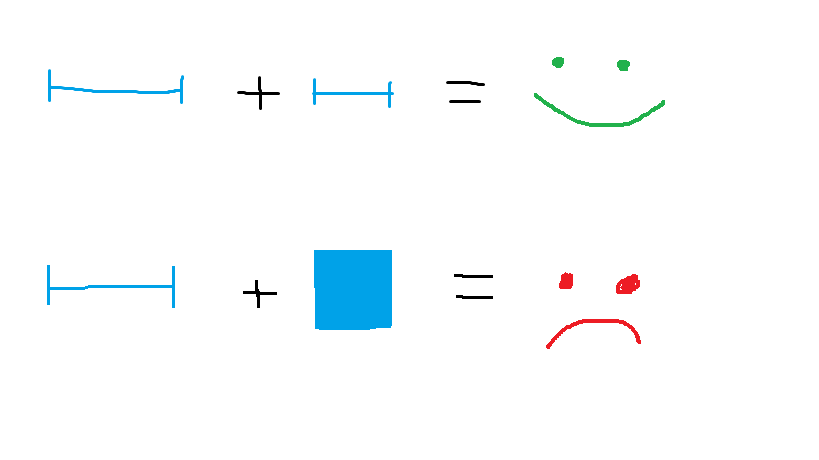Type-level dimensions
module Dimensions.TypeLevel
( Dim(..)
, Mul
, Div
, Length
, Mass
, Time
, Current
, Temperature
, Substance
, Luminosity
, One
) whereWe will now implement type-level dimensions. What is type-level? Programs (in Haskell) normally operatate on (e.g. add) values (e.g. 1 and 2). This is on value-level. Now we’ll do the same thing but on type-level, that is, perform operations on types.
What’s the purpose of type-level dimensions? It’s so we’ll notice as soon as compile-time if we’ve written something incorrect. E.g. adding a length and an area is not allowed since they have different dimensions.

This implemention is very similar to the value-level one. It would be possible to only have one implementation by using Data.Proxy. But it would be trickier. This way is lengthier but easier to understand.
To be able to do type-level programming, we’ll need a nice stash of GHC-extensions.
{-# LANGUAGE DataKinds #-}
{-# LANGUAGE GADTs #-}
{-# LANGUAGE KindSignatures #-}
{-# LANGUAGE TypeFamilies #-}
{-# LANGUAGE UndecidableInstances #-}
{-# LANGUAGE TypeOperators #-}See the end of the next chapter to read what they do.
We’ll need to be able to operate on integers on the type-level. Instead of implementing it ourselves, we will just import the machinery so we can focus on the physics-part.
We make a kind for dimensions, just like we in the previous section made type for dimensions. On value-level we made a type with values. Now we make a kind with types. The meaning is exactly the same, except we have moved “one step up”.
data Dim = Dim TypeInt -- Length
TypeInt -- Mass
TypeInt -- Time
TypeInt -- Current
TypeInt -- Temperature
TypeInt -- Substance
TypeInt -- LuminosityBut data Dim = ... looks awfully similar to a regular data type! That’s correct. But with the GHC-extension DataKinds this will, apart from creating a regular data type, also create a kind. Perhaps a less confusing syntax would’ve been kind Dim = .... The above definition can be seen as the two following definitions.
Thanks to the Dim-kind we can force certain types in functions to be of this kind.
This may sound confusing, but the point of this will become clear over time. Let’s show some example types of the Dim-kind.
type Length = 'Dim Pos1 Zero Zero Zero Zero Zero Zero
type Mass = 'Dim Zero Pos1 Zero Zero Zero Zero Zero
type Time = 'Dim Zero Zero Pos1 Zero Zero Zero Zero
type Current = 'Dim Zero Zero Zero Pos1 Zero Zero Zero
type Temperature = 'Dim Zero Zero Zero Zero Pos1 Zero Zero
type Substance = 'Dim Zero Zero Zero Zero Zero Pos1 Zero
type Luminosity = 'Dim Zero Zero Zero Zero Zero Zero Pos1'Dim is used to distinguish between the type Dim (left-hand-side of the data Dim definition) and the type constructor Dim (right-hand-side of the data Dim definition, with DataKinds-perspective). 'Dim refers to the type constructor. Both are created when using DataKinds.
Pos1, Neg1 and so on corresponds to 1 and -1 in the imported package, which operates on type-level integers.
Exercise Create types for velocity, acceleration and the scalar.
Solution
Multiplication and division
Let’s implement multiplication and division on the type-level. After such an operation a new dimension is created. And from the previous section we already know what the dimension should look like. To translate to Haskell-language: “after such an operation a new type is created”. How does one implement that? With type family! A type family can easiest be thought of as a function on the type-level.
type family Mul (d1 :: Dim) (d2 :: Dim) where
Mul ('Dim le1 ma1 ti1 cu1 te1 su1 lu1)
('Dim le2 ma2 ti2 cu2 te2 su2 lu2) =
'Dim (le1+le2) (ma1+ma2) (ti1+ti2) (cu1+cu2)
(te1+te2) (su1+su2) (lu1+lu2)type familymeans it’s a function on type-level.Mulis the name of the function.d1 :: Dimis read as “the typed1has kindDim”.
Exercise As you would suspect, division is very similar, so why don’t you try ’n implement it yourself?
Solution
Exercise Implement a type-level function for raising a dimension to the power of some integer.
Solution
Now types for dimensions can be created by combining exisiting types, much like we did for values in the previous chapter.
Exercise Create types for velocity, area, force and impulse.
Solution
Perhaps not very exiting so far. But just wait ’til we create a data type for quantities. Then the strenghts of type-level dimensions will be clearer.